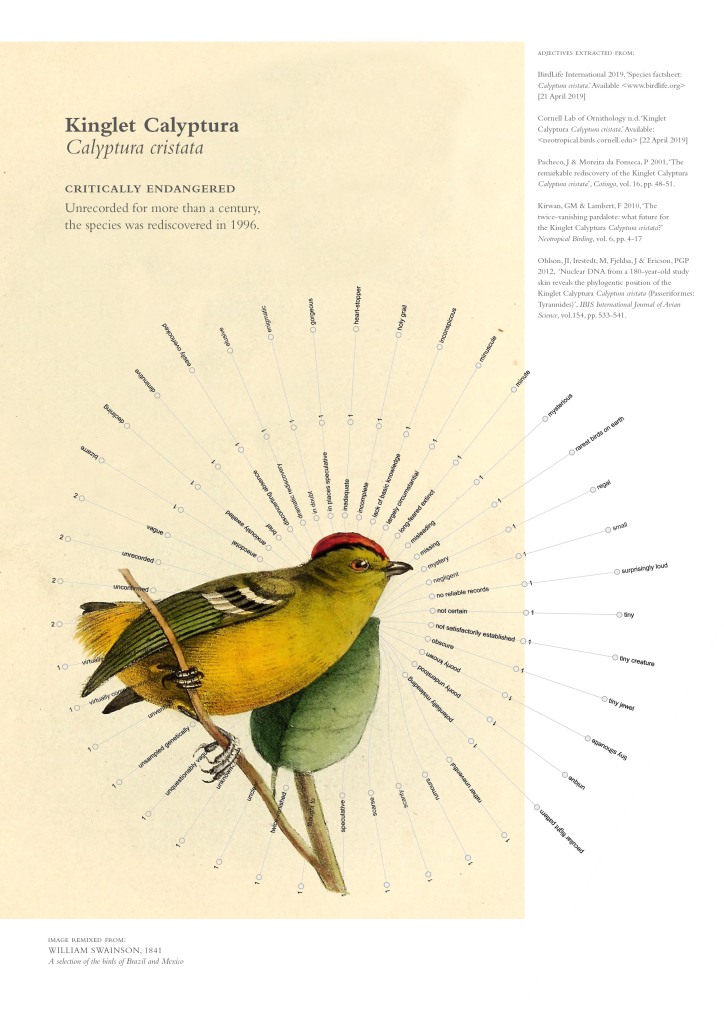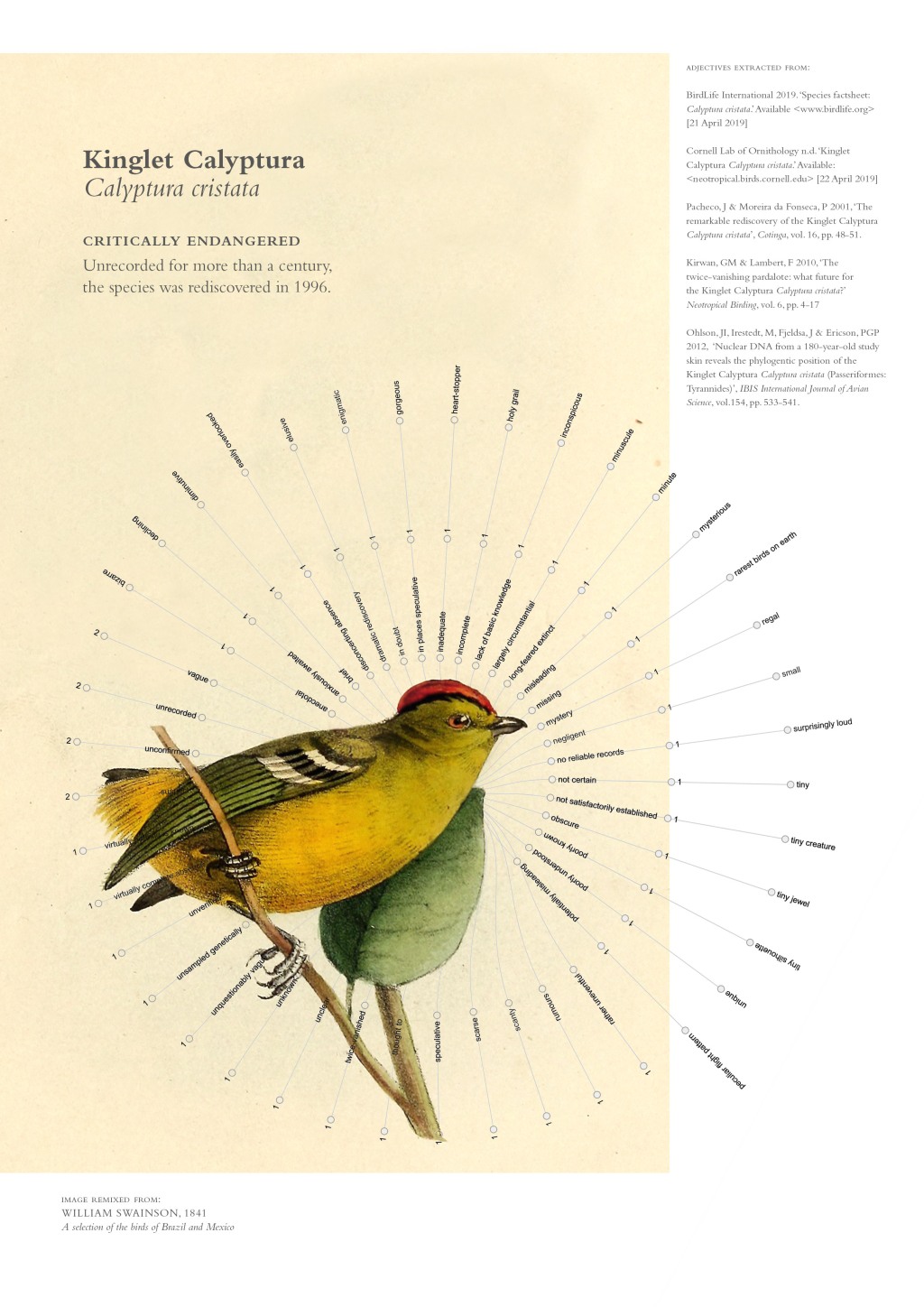
Aim (Experiment 1)
I was struck by the descriptive language used to describe both the bird and the lack of knowledge about the species. For example, from the Cornell Lab of Ornithology, this paragraph:
The Kinglet Calyptura is among the most enigmatic and poorly understood species of Neotropical birds. A bizarre bird, it resembles a kinglet (Regulus) in size and shape, but its true taxonomic affinities remain unclear. While a number of specimens were obtained prior to the beginning of the Twentieth Century, it was unrecorded for over a hundred years before its dramatic rediscovery in 1996. Virtually nothing is known of its habits, although it is thought to feed on insects and small fruits.”
How might I show that the language used to describe both the Kinglet calyptura and the lack of information about this species forms a particular (mysterious?) narrative? [phrase this better]
Process (experiment 1):
- Source articles and fact sheets on Kinglet calyptura:
– Ohlson et. al. 2012. ‘Nuclear DNA from a 180-year-old study skin reveals the phylogentic position of the Kinglet Calyptura Calyptur cristata (Passeriformes: Tyrannides)’, IBIS International Journal of Avian Science. 154. pp. 533-541.
– Kirwan, G.M. and Lambert, F. 2010. ‘The twice-vanishing pardalote: what future for the Kinglet Calyptura Calyptura cristata?’ Neotropical Birding. 6. pp. 4-17
– Fernando Pacheco, J. and Moreira da Fonseca, P.S. 2001, ‘The remarkable rediscovery of the Kinglet Calyptura Calyptura cristata, Cotinga. 16. pp. 48-51.
– Cornell Lab of Ornithology n.d. ‘Kinglet Calyptura Calyptura cristata’. Online: <neotropical.birds.cornell.edu/> Accessed 22 April 2019.
– BirdLife International (2019) Species factsheet: Calyptura cristata. Downloaded from http://www.birdlife.org on 21 April 2019. - Extract adjectives (close reading of texts, organise into an excel doc) related to:
i) characteristics of species
ii) knowledge of species - Overlay these terms on an image of the species (sourced from Wiki Commons, credited to William Swainson, 1841 from the book A selection of the birds of Brazil and Mexico. [Public Domain].)
Initial ideas: visualise words as clouds, network diagram? A cage surrounding the bird?
Decided to test visualisation software RAWgraphs: https://rawgraphs.io/
Reflection on action:
- Problems with free software.
I have no idea how to prepare Excel spreadsheets to input into RAWgraphs. Even Andrew Burrell found it confusing when I asked for help, which leaves me little hope. Could have invested time figuring it out, didn’t see the value in that, so used the software to create a confusing data visualisation from the adjectives I’d extracted from the readings. This works for the aim – to show that the species is enigmatic and poorly understood. It also taps into my other ‘speculative diagrams’ project and reminds me to look for the person I follow on Instagram making nonsense diagrams.
- Setting a proper grid.
After deciding, in conversation with Timo, that I would do this whole series as digital collages primarily using found images (and he will cross stitch) I feel I need to set a standard size to work from, set up a grid and typesetting styles.
Clarity of communication?
Enjoyed tooling around with the text analysis / data viz for this one, but wondering if the final image is too difficult to comprehend? Perhaps need to look back to more successful experiments to see how much info was included to make them clearly communicate, or just leave these now and return to them all at the end and layer in more data/information if needed? Will think through more.
Another line of thinking (eventually, experiment 2):
Does a bird calling in the forest make sound, if no human hears it?
If no scientist, or citizen scientist, records it?
At the ALN residency, Timo and I share our work with Olga, a Polish artist based in Amsterdam. Her large-scale drawings are beautifully slow, detailed renderings which occasionally require her to perch on a ladder for hours at a time. Looking at one of my Mangrove finch drawing exercises, she mentions the recent scientific rediscovery of a rabbit size deer in Vietnam. Her face lights with wonder as she describes the creature. We had discussed, just this morning over porridge-making in the kitchen, our shared affection for deer – Olga regretted that no deer are present here, despite being known locally as garden-wreckers, and I told her about feeding deer biscuits in Nara, Japan, just weeks ago.
‘Rediscovery’ in 2019 of Tragulus versicolor, the silver-backed chevrotain (also called the Vietnamese mouse-deer), a rabbit-sized ‘miniature fanged deer’ (they have tusk-like incisors).1 Chevrotains are neither deer nor mice, but the smallest ungulates (hoofed mammals) in the world. No sightings had been reported since 1990, when a hunter found, killed and donated a specimen to scientists. However, driven by lucrative demand for bushmeat in East Asia, illegal hunting using wire snares is prevalent (see also catastrophic pangolin poaching). Scientists associated with the Global Wildlife Conservation spent time gaining the trust of locals, who no-doubt feared reprimand for laying wire snares which indiscriminately ‘lay waste’ to wildlife resulting in what is known as ‘empty forest syndrome.’2 Eventually, scientists were taken to sites the locals believed they’d seen the silver-backed chevrotain (which looks similar to a more common species, the lesser-mouse deer) and the scientists set different kind of snares – camera traps, to capture the elusive creatures, which they did successfully in 2019, giving hope to other species which are declared ‘missing to science’ or ‘data deficient’.3
This anecdote ignites multiple uncomfortable conversations, including social justice issues associated with capitalist systems of consumption and profit, and the colonialism embedded in traditional scientific methods. Here, I tread on eggshells; I’m well beyond the bounds of my scholarly expertise, it would be safer and simpler to omit this paragraph, but I leave it here, to return to later.
- https://www.nationalgeographic.com/animals/2019/11/silver-backed-chevrotain-mouse-deer-reappears-vietnam/
- https://blog.nationalgeographic.org/2017/02/08/reversing-empty-forest-syndrome-in-southeast-asia/
- See also https://www.globalwildlife.org/search-for-lost-species/
Politics of representation.
In his book Against the Anthropocene, T.J. Demos asks “how does the Anthropocene enter into visuality and what are its politics of representation?” How might we “comprehend the present intersection of human culture and the environment that is remaking the world as we know it?”
I have to consider, what kinds of thresholds to interpretation do I set up by using these historical zoological illustrations as the base of my collages? Without thinking too critically, I use these images for several reasons:
- I find them aesthetically appealing; I have fetishised such images for as long as I can remember. I have a distinct memory of browsing encyclopedias in my primary school library (small-town Australia in the 1980s) – mesmerised by these images, not bothering to read the written entries.
- They are in the public domain which allows me to produce quick digital collages and illustrations, to work through ideas and stories about these birds.
- Some birds I’m considering were extinct before they could be photographed, or, like the Kinglet calyptura, are elusive and few other representations exist.
How might I produce or work with other kinds of representation (I started drawing the Mangrove finch to move away from found images) – or how might I draw out the politics of representation embedded within these scientific images?

Leave a comment